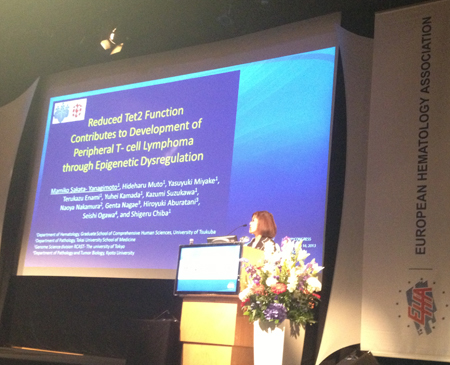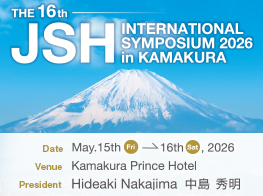
名前:坂田 麻実子【筑波大学医学医療系血液内科】
発表日時:2013年6月16日
発表形式:Oral
Title:
REDUCED TET2 FUNCTION CONTRIBUTES TO DEVELOPMENT OF PERIPHERAL T-CELL LYMPHOMA THROUGH IMPAIRMENT OF EPIGENETIC REGULATION
Authors:
Mamiko Sakata-Yanagimoto1, Hideharu Muto1, Genta Nagae2, Yasuyuki Miyake1, Terukazu Enami1, Yuhei Kamada1, Takayasu Kato1, Hidekazu Nishikii1 Kazumi Suzukawa1, Naoya Nakamura3, Hiroyuki Aburatani2, Seishi Ogawa4, Shigeru Chiba1
Affiliations:
1Department of Hematology, Graduate School of Comprehensive Human Sciences, University of Tsukuba
2Genome Science Division, Research Center for Advanced Science and Technology (RCAST), The University of Tokyo
3Department of Pathology, Tokai University School of Medicine
4 Cancer Genomics Project, Graduate School of Medicine, The University of Tokyo
Abstract:
Background
TET family proteins convert methylcytosine (mC) to hydroxymethylcytosine (hmC). Loss-of-function mutations in TET2 were initially reported in various types of myeloid malignancies, and later also in specific subtypes of lymphoid malignancies. TET2 mutations are found more frequently in angioimmunoblastic T-cell lymphoma (AITL) and peripheral T-cell lymphoma, not otherwise specified (PTCL-NOS) with AITL-like features than PTCL-NOS without those or other types of lymphomas. The tumor origin of AITL is thought to be follicular helper T cells (Tfh). Tet2 knockout mice demonstrated premalignant status of myeloid lineages, implicating that loss-of-function mutations of TET2 play an important role in myeloid malignancies; however, there are no clues how impaired Tet2 function provokes T-cell lymphomas.
Aims
We analyzed Tet2 gene trap mice to analyze the role of TET2 in T-cell lymphomagenesis.
Methods
The Tet2gt locus has a trapping vector inserted into the second intron of Tet2 locus. Bone marrow, spleen, and tumors when developed were analyzed in adult Tet2gt/gt mice by flow cytometry and immunohistochemical staining. The comprehensive gene-expression profiles of tumors were assayed by microarray and the data was analyzed by Gene Set Enrichment Analysis (GSEA). The patterns of hmC were analyzed by hmDIP, followed by high throughput sequencing.
Results
Adult mice were obtained after crossing Tet2+/gt mice under the following ratio; Tet2+/+:Tet2+/gt:Tet2gt/gt=48:52:25. The Tet2 mRNA expression level in Tet2gt/gt Lin- FL cells was reduced to 20% of that in WT Lin- FL cells, while the hmC level to around a half of that in WT cells. In the spleen of 40 week-old mice, the proportion of CD4+/PD1+/CXCR5+ cells, immunophenotypically similar to Tfh, was significantly increased in Tet2gt/gt mice compared to Tet2+/+ mice (P=0.022). Five out of the 7 Tet2gt/gt mice aged 60 weeks or older (median, 67 weeks) developed marked splenomegaly with swollen lymph nodes and multi-nodular tumors in liver and lungs. Histological examination of the enlarged spleen and swollen lymph nodes in these 5 mice demonstrated completely destroyed follicular structures and infiltration of morphologically abnormal lymphocytes, which showed the CD4+/PD1+/CXCR5dull phenotype. CD4+ cells purified from the tumors revealed restricted rearrangement patterns of T-cell receptor gamma gene, implying a signature of T-cell lymphoma. CD4+ cells purified from the lymphomas represented similar gene-expression profiles with Tfh cells, i.e., high expression of Bcl6 and c-Maf, two key transcription factors of Tfh. The patterns of hydroxymethylation were distinct between CD4+ cells purified from Tet2gt/gt mice and those from control mice.
Discussion
Our observations indicate that reduced expression of Tet2 leads to proliferation of Tfh cells and eventually to development of lymphomas that pathologically recapitulate PTCL-NOS with characteristics of Tfh in humans. These data suggest that TET2 serves as a gatekeeper of lymphoid malignancies in addition to myeloid malignancies.
印象記
この度はストックホルムで行われた18th EHA congressに参加する機会をいただきまして、誠にありがとうございました。
行きはパリ乗り換えでストックホルム行きの便に乗る予定でしたが、ストライキのため飛行機が飛ばず、一日パリで過ごす羽目となりました。パリでは、東京医科歯科大学の新井文子先生に声をかけていただき、心細い中を助けていただきました。女性医師、女性研究者の大先輩であることが判明し、人の輪が増えましたのは不幸中の幸いです。
EHAは、予想していたより大勢の方が参加されていて、大変activeな議論がなされていました。歴史のある都市の中で、サイエンスを楽しむ、という姿勢が感じられました。
私自身は、今の仕事に関係のあるリンパ腫、MDS、MPN、造血障害の基礎的なセッションを中心に参加いたしました。次世代シークエンサーにより見えてきた世界観が話題の中心であるのは、昨今の風潮ですが、ただ新しい変異をみつけた、という意味ではもはや大きな報告はなく、一歩踏み込んだ議論がなされていました。特に、腫瘍クローンはどこからはじまるか、また、腫瘍の中のクローンのheterogeneity(不均一性)については、引き続き興味深い進捗が報告されていました。一方で、改めて機能解析にもスポットライトがあたっているようにも感じられました。ポストゲノム、と呼ばれる時代、遺伝子変異パターンが一通り明らかになった後、さて、腫瘍の病態はどこまで明らかになったか、さらには腫瘍を治すにはどのように取り組めばよいのか、ということを自分の研究と重ね合わせながら考えさせられました。
私自身は、造血不全(潜在的な造血不全を含めて)を背景とする末梢性T細胞リンパ腫の研究に取り組んでおります。今回は、エピゲノム調節因子であるTET2遺伝子のT細胞リンパ腫における変異解析結果とTet2ノックダウンマウスによるT細胞リンパ腫モデルについて報告いたしました。座長のM. Paulli博士はリンパ腫について多数の論文を執筆されている血液病理医の方でした。セッションが終わった後にcongratulation!と声をかけていただきまして、共同研究しないかとお誘いいただきました。今回の発表が国際的な人の輪ができるきっかけになり、大感激いたしました。
Travel award受賞者の交流会では、女性研究者としての活動に大変に暖かい励ましをいただきました。これまで振り返りますと、数年程前に最も辛いピークがあったように思います。研究、臨床、育児、と自分自身でも十二分に努力しなくては毎日が過ぎていかないように感じていました。しかし、落ち着いて周囲が見えるようになりますと、自分自身の努力では全く不十分で、むしろ“ニッチ”側からの大きなサポートがあってこそ今があることにようやく気づく余裕がでてきたように思います。私にとっての“ニッチ”は、筑波大学血液内科の同僚の先生方、また研究の発展に共に努力してくれている後輩であると思います。
末尾になりますが、今回このような機会をいただきまして、日本血液学会 事務局、国際委員会の方々、また、日ごろから研究を指導してくださっている恩師、千葉滋先生に感謝いたします。




